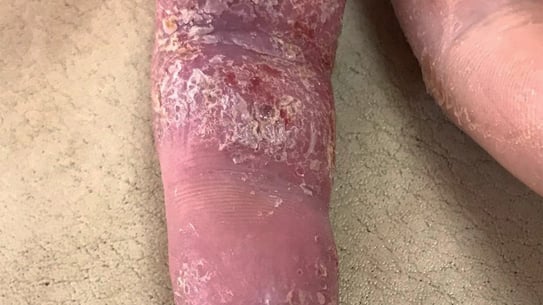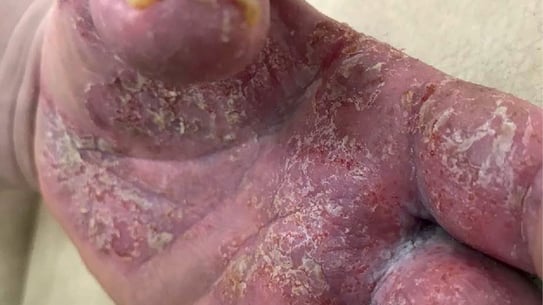0 professionals
Marc, 43 years old, “Hands in the air”
Marc, 43 years old, “Hands in the air”
URL copied
Written with the participation of FDVF (Future Dermatologists and Venereologists of France) interns.
Related topics



10 respondents
Question of 1
Palmar psoriasis
Wrong answer!
It was dyshidrotic eczema.
Let’s rule out differential diagnoses:
A personal or family history of psoriasis may help determine the diagnosis. The palmar lesions may also take on a pustular appearance. There is some overlap between palmar psoriasis and chronic hand eczema, both of which are treated with high potency topical corticosteroids and respond to retinoids and methotrexate.
Contact eczema is highly erythematous and very well defined, with a clear edge. The allergen may be occupational or be present during certain leisure activities.
Tinea manuum lesions affecting the hand will usually develop as “two feet-one hand” syndrome. This may be revealed by simple palmar hyperkeratosis. When the lesions are erythematous, there is healing of the centre of the lesion with a pustular active edge.
Contact eczema
Wrong answer!
It was dyshidrotic eczema.
Let’s rule out differential diagnoses:
A personal or family history of psoriasis may help determine the diagnosis. The palmar lesions may also take on a pustular appearance. There is some overlap between palmar psoriasis and chronic hand eczema, both of which are treated with high potency topical corticosteroids and respond to retinoids and methotrexate.
Contact eczema is highly erythematous and very well defined, with a clear edge. The allergen may be occupational or be present during certain leisure activities.
Tinea manuum lesions affecting the hand will usually develop as “two feet-one hand” syndrome. This may be revealed by simple palmar hyperkeratosis. When the lesions are erythematous, there is healing of the centre of the lesion with a pustular active edge.
Dyshidrotic eczema
Dyshidrotic eczema
It is indeed dyshidrotic eczema.
Let’s rule out differential diagnoses:
A personal or family history of psoriasis may help determine the diagnosis. The palmar lesions may also take on a pustular appearance. There is some overlap between palmar psoriasis and chronic hand eczema, both of which are treated with high potency topical corticosteroids and respond to retinoids and methotrexate.
Contact eczema is highly erythematous and very well defined, with a clear edge. The allergen may be occupational or be present during certain leisure activities.
Tinea manuum lesions affecting the hand will usually develop as “two feet-one hand” syndrome. This may be revealed by simple palmar hyperkeratosis. When the lesions are erythematous, there is healing of the centre of the lesion with a pustular active edge.
Dermatophytosis
Wrong answer!
It was dyshidrotic eczema.
Let’s rule out differential diagnoses:
A personal or family history of psoriasis may help determine the diagnosis. The palmar lesions may also take on a pustular appearance. There is some overlap between palmar psoriasis and chronic hand eczema, both of which are treated with high potency topical corticosteroids and respond to retinoids and methotrexate.
Contact eczema is highly erythematous and very well defined, with a clear edge. The allergen may be occupational or be present during certain leisure activities.
Tinea manuum lesions affecting the hand will usually develop as “two feet-one hand” syndrome. This may be revealed by simple palmar hyperkeratosis. When the lesions are erythematous, there is healing of the centre of the lesion with a pustular active edge.
Very high-potency topical corticosteroids (clobetasol propionate) should be used: one 10g tube per day.
Topical calcineurin inhibitors may be used.
If a dermatosis is resistant to local treatment, or if it is too steroid-dependent and disabling from day to day, phototherapy, alitretinoin (TOCTINO) or methotrexate may be proposed.
We can recommend a repair cream that may be reapplied several times a day.
Create easily your professional account
I create my accountGet access to exclusive dermatological services to increase your professionnal knowledge: +500 pathology visuals, clinical cases, expert videos
Benefit from valuable features: audio listening, materials to be shared with your patients
Stay informed about the upcoming events and webinars, latest scientific publications and product innovations